- Belgium comes to Yamashita Park
- Residential Villa in Phuket Entices Remote Workers With Long-Stay Rates
- Rare pieces of French glass art at the Mirai Museum of Art
- Feast on fresh fish and seafood at the 2024 ‘Sakana’ Festival
- Would you like to ride in a Louis Vuitton gondola lift?
- Naked Snow Aquarium
- Festive lights at Yomiuriland will get you feeling the holiday vibes
Best family travel destinations

Looking for the perfect getaway? Whether your bags are packed, ready to go or still wondering where to travel next as a family, get some tips to add to your bucket list from globe-trotting families in Tokyo.
CAMBODIA
When planning our trip, we knew we wanted to spend sufficient time exploring the temples around Siem Reap. We spent five days there but could have easily stayed ten. The temples, including Angkor Wat, possess an unspeakable beauty. As my husband and I wandered around with mouths agape, our sons ventured into their own magical worlds – imagining themselves as explorers or demon-fighting deities churning the cosmic sea of milk. The boys were also occupied with the discovery of interesting insects and animals, including giant centipedes, scorpions, lizards and many frogs – some as small as their fingertips. They also walked along water buffalo, rode elephants and followed behind wild monkeys. A word of warning: monkeys sometimes bites!
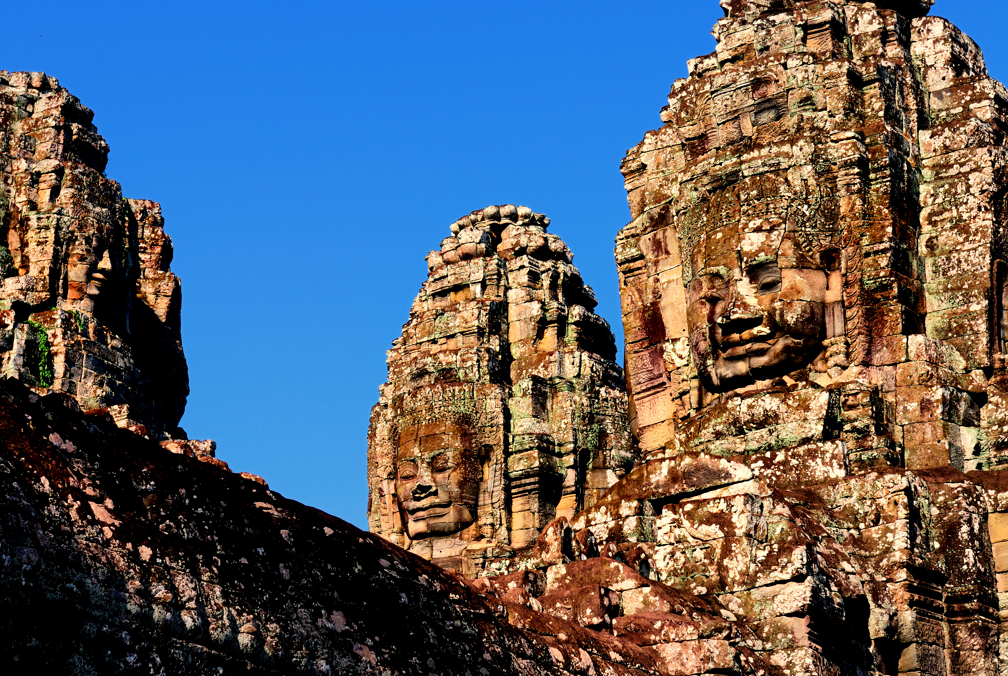
photo by Marcin Baranowski
There are usually tents set up outside the temples to offer water, souvenirs and food to tourists. The myriad souvenir offerings in Siem Reap included beautiful scarves, fabric, and fascinating books on Cambodia.
Another thing that made our time in Siem Reap so enjoyable was that we hired a driver, Mono, who quickly became a friend and an invaluable tour guide. He guided us to temples that were not typical tourist spots, while maintaining a careful distance from sites believed to still possess landmines. Mono stopped at small roadside stall for us to try treats like palm-sugar candy. Mono also related personal stories about his childhood including growing up during the Khmer Rouge period and other family experiences, thus sharing a deeply personal side of Cambodia.
After visiting Siem Reap, we took an airplane to Phnom Penh and then rode a bus for 5 hours to Sihanoukville, along the southern coast of Cambodia. The beach and our accommodations were a bit rustic there, but slow pace and simplicity was a real treat. We spent our days reading and swimming in the turquoise waters of the Gulf of Thailand, then enjoyed our dinner seated at candlelit tables along the beach. While sampling spicy curry and nodle dishes accompanied by exostic fruit smoothies, we quietly stared at the bio-luminescent plankton twirling in the water. Our time in Sihanoukville was probably the happiest our family has ever been.
After Sihanoukville, we spent a few days in the capital city of Phnom Penh. The city assaults the senses with hundreds of motor bikes – each carrying up to four people – weaving in and out of traffic comprised by tuk-tuks, overloaded trucks, cars, and hardy pedestrians. After the relatively clean and tourist-oriented Siem Reap, the relaxed Sihanoukville, Phnom Penh seemed gritty and bustling.
We made the difficult decision to visit the Tuol Sleng Genocide Museum, which was home to some of the worst atrocities of the Khmer Rouge regime. At no age is one prepared to comprehend the horrors that occurred during this time. Tuol Sleng allowed us to see Cambodia not just as beautiful and rustic land, but as a country whose people have worked so hard to recover from the worst imaginable terrors. Sadly, Cambodia is still an impoverished nation with many problems, but the Cambodians’ optimism is infectious and endearing. When our sons are older, we plan to return on a working visit to help dig wells or build schools and medical facilities.
After Cambodia, it has been difficult for our family to see the world the same way again. We only spent ten days there but Cambodia found a place deep in our hearts forever.
Access
Direct flights to Phnom Penh and Siem Reap from Bangkok, HoChi Minh, Kuala Lumpur, Singapore, Hong Kong, Vientiane and Guangzhou.
Information
The official currency is the riel but US dollare are preferred in major towns and cities. Major credit cards are not widely accepted so cash is recommended. There are also a few ATM machines, making getting cash difficult and inconvenient. Several vaccines are recommended. For details, www.cdc.gov/travel/destinationCambodia.aspx
Helpful Tips
If you plan on exploring the temples around Siem Reap, good footwear is a must. The climbing can ve very difficult and the amount of walking can be exhausting. Cambodians dress nicely and are very modest. It is not polite to wear shorts or shirts that exposed the shoulders when visiting the temples.
Take strong insect repellant and spray your clothes before you leave. Humidity is low in Dec and Jan. but starts to rise in Feb. Rainy season lasts from May to Oct.
Hire a driver. Have your hotel arrange this or e-mail our driver Mono at monotopbanana@yahoo.com. Most drivers charge around $25 a day.
TAHITI (Papeete)
They say a picture is worth a thousand words. Just by looking at a picture of gorgeous lagoons and less busy environment in Tahiti, my husband and I didn’t have second thoughts as to where to go for our 15th wedding anniversary with the kids. It was the perfect dream trip we had fantasized about for many years.
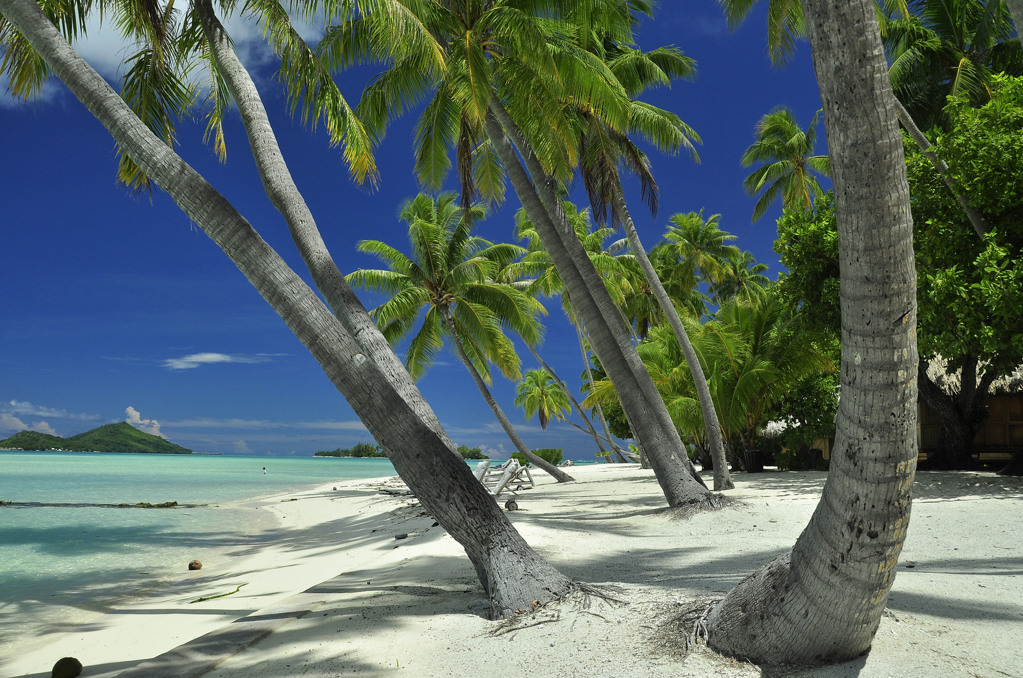
Photo by Matt Diehl
Tahiti can be an expensive travel but it doesn’t have to be if you do your research months before the trip like we did. Instead of staying at a hotel, we chose a bed and breakfast Pension in Papeete, the capital city of Tahiti. A Pension is a large house with a bathroom in each room for 89 euros a night (approx 13,000 yen) for a group of 4. Food is expensive in the city so we had most of our meals at Les Roulottes (or food trucks) which is open all day long. For less than 7 euros (approx 1,000 yen), you can have a satisfying meal ranging from steak sandwiches, fresh grilled fish to French crepes. Live music plays in the background while enjoying a scenic view of the waterfront at Vai’ete Square. The fun doesn’t start until 6pm on to 3 am the next day.Tahitian (Reo Maohl) and French are the two languages predominantly spoken in the island although it is not difficult to get by in English.
BORA BORA
A 40-minute plane hop from Papeete took us to paradise – Bora Bora island, which was the highlight of our journey.
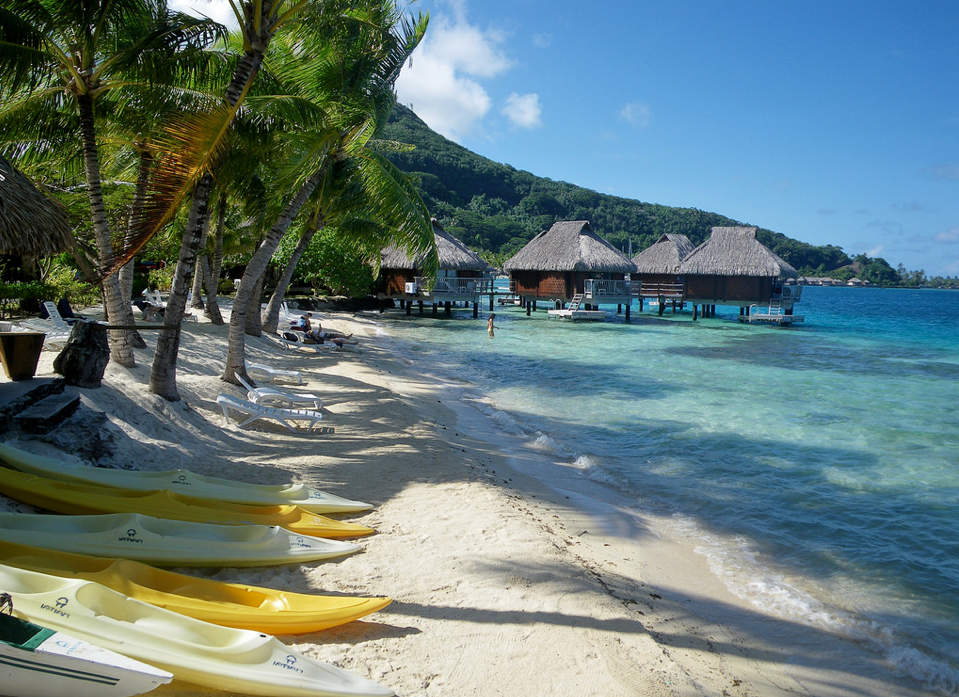 This part of French Polynesia is probably the most famous of all the Society Islands in the pacific and a major tourist destination. It attributes its popularity to the iconic lagoons, clear water and scenic waterfront. The only caveat is the pricey accommodation. Five-star over-the-water bungalows is standard in the area with price usually ranging from 75,000 yen to 106,000 yen per night.
This part of French Polynesia is probably the most famous of all the Society Islands in the pacific and a major tourist destination. It attributes its popularity to the iconic lagoons, clear water and scenic waterfront. The only caveat is the pricey accommodation. Five-star over-the-water bungalows is standard in the area with price usually ranging from 75,000 yen to 106,000 yen per night.
With a little more internet research, we found a good deal at Sofitel Bora Bora Marara Private Beach Resort for a little less than 30,000 yen a night for the four of us. Resort huts are paid per unit as opposed to Japan’s per person system. We had a choice between one with a blue lagoon view and over-water bungalow. The bungalow we picked came complete with free wi-fi, flat screen TV, air conditioning, a terrace and a superb view of the white sand beach. The service was impeccable and another thing that made our trip even more fulfilled was the delicious food. We are all adventurous eaters and luckily the place did not disappoint.
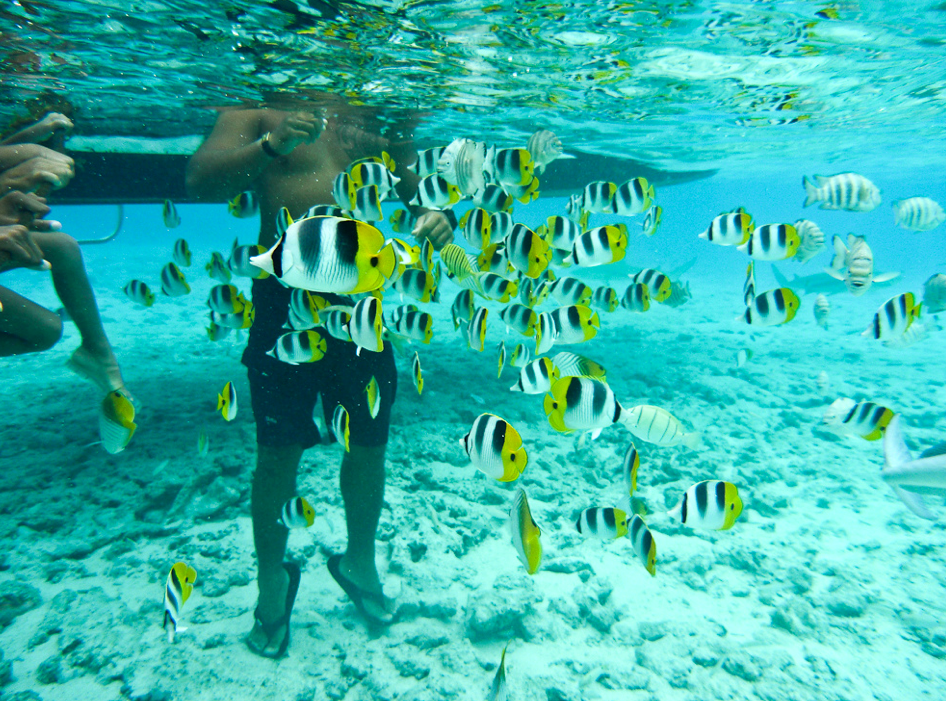 Unlike Hawaii though where you can find almost any kind of cuisine, Bora Bora has less variety but excellent in quality. The food in the island is a mix of fresh exotic and Parisian bistro. Fish wrapped in banana leaves and cooked over charcoal instantly became a family favourite. Tropical fruits abound but the most appealing to us was the uru (breadfruit) considered to be the king of all fruits in the island. The kids love it, they ate it day and night!
Unlike Hawaii though where you can find almost any kind of cuisine, Bora Bora has less variety but excellent in quality. The food in the island is a mix of fresh exotic and Parisian bistro. Fish wrapped in banana leaves and cooked over charcoal instantly became a family favourite. Tropical fruits abound but the most appealing to us was the uru (breadfruit) considered to be the king of all fruits in the island. The kids love it, they ate it day and night!
While Tahiti is famous for black sand beaches, Bora Bora is mostly white sand.
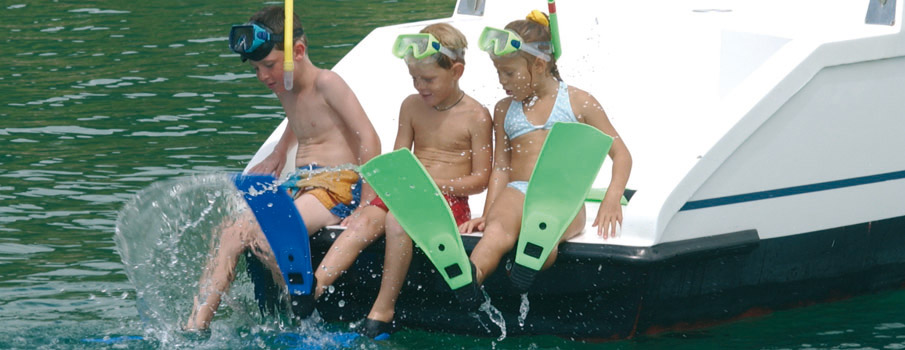 There are so many kid-friendly activities to be enjoyed in the island such as diving, snorkeling, a visit to pearl museums and one thing you should not leave without experiencing is the lagoon trekking. The waters are fairly shallow, just about 10 feet which the kids enjoyed. Underwater, we came up close with the all sorts of attractive looking aquatic animals such as Napoleon fish that changes its colors from blue to gray, the bright yellow clown fish, the polynesian eel and the most shy of them all, the sting ray that buries itself in the sand.
There are so many kid-friendly activities to be enjoyed in the island such as diving, snorkeling, a visit to pearl museums and one thing you should not leave without experiencing is the lagoon trekking. The waters are fairly shallow, just about 10 feet which the kids enjoyed. Underwater, we came up close with the all sorts of attractive looking aquatic animals such as Napoleon fish that changes its colors from blue to gray, the bright yellow clown fish, the polynesian eel and the most shy of them all, the sting ray that buries itself in the sand.
Bora Bora waters are not known to be surfer friendly. You will have to go to Huahine or Moorea for more waves and the best swell direction.
As we came close to what has been a fun week-long dream trip, it became difficult to say nana (goodbye in Tahitian language) to all the friends we have made. Instead, we bid them au revoir because we know we will be back at some point.
August is the perfect month to visit but with the intense South Pacific heat, you may need to bring lots of sunscreen with maximum protection which can be very expensive locally. Also take mosquito repellant. It comes handy at sunset.
OKINAWA
Looking for a tropical escape but don’t want to head to Hawaii or Guam? It’s easy to forget that Japan possesses her own piece of paradise: The Ryukyu Islands. As a chill creeps into the city air, it’s the perfect time to head south to balmy Okinawa and check out all that this tropical destination has to offer.

Okinawa
Though there are several dozen islands in the Ryukyu chain, you’ll find enough to do on the main island of Okinawa itself to keep you and your little ones busy for days. Start out in Naha, the island’s main metropolis, where big city bustle mixes with a laid-back beach vibe. Be sure to stroll along Kokusai-dori, the main shopping avenue, which boasts everything from local jewelry and gifts to specialty ice cream and Okinawan donuts. On weekends, the thoroughfare is closed to traffic and street musicians come out in force.
For a glimpse of old-fashioned Okinawa, head up the highway to Ryukyu Mura, a hands-on village of traditional houses. Hourly performances showcase the island’s diverse cultural traditions, while craftsy kids can try their hand at painting their own shisa (guardian lion-dogs) or decorating bingata cloth. Don’t miss the chance to meet Okinawa’s famous serpentine residents at the Habu House or watch sugar being made near the park’s exit.
Nearby, in the island’s interior, Bios on the Hill offers families the chance to explore Okinawa’s various plants and resident animals. Boats cruise down the park’s waterways for a relaxing view of the lush surroundings; if you’re up for an adventure, you can explore the waters with one of the park’s canoes. Or, stick to solid ground and take a ride on Bio’s newest attraction, a carriage pulled by water buffalo.
Further north, get a taste (literally!) of one of the island’s top exports at the Nago Pineapple Park. Pineapple-adorned carts roll visitors through the plantation’s gardens, where row after row of the sweet fruit can be seen. Inside the building, visitors are treated to a host of free samples ranging from pineapple cakes and candies to crisp pineapple juices and wines.
End your explorations on the Motobu Peninsula, where the island’s top-notch Churaumi Aquarium draws numerous visitors to this remote stretch of land. With giant-size tanks that house thousands of species of fish, including massive whale sharks and delicate manta rays, it’s the perfect place to explore Okinawa’s ocean wonders without getting your feet wet. Of course, if you’re up for a splash, head down to the waterfront for the daily dolphin show where the aquarium’s playful residents delight (and soak!) audiences with a variety of tricks.
With sun, shopping and the turquoise-colored sea never more than a few minutes away, Okinawa is the perfect island escape for families this fall.
Okinawa is reachable by plane from either Narita Airport or Haneda Airport. Three-hour flights to Naha cost, on average, between ¥12,000 and ¥15,000 one way. A car is recommended on Okinawa for easier access to sites north of Naha.










